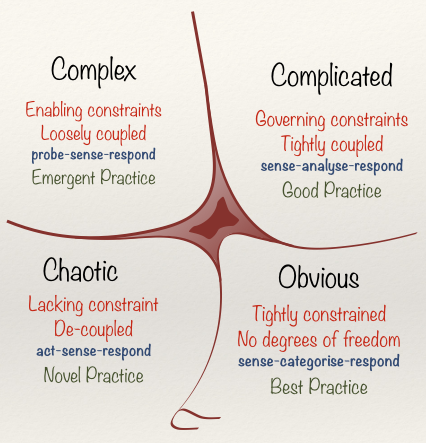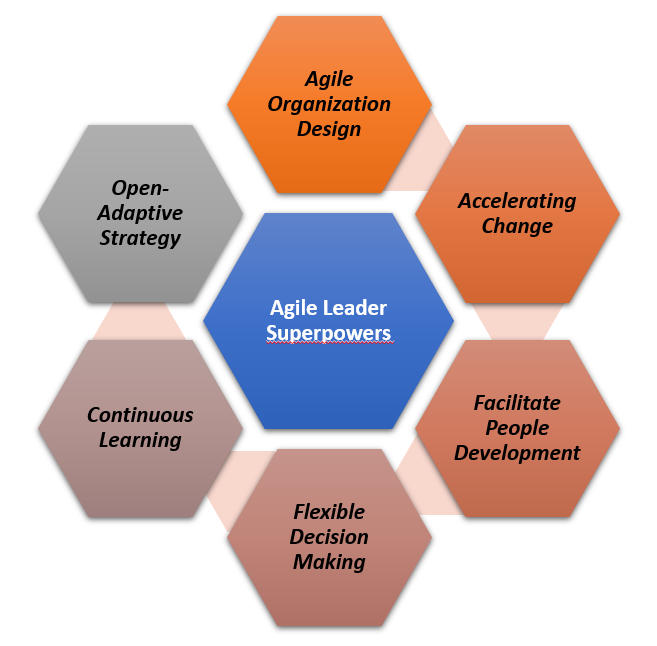Leading organizations today, is quite challenging. More than often, leaders are asked to move among fog and unknown lands, where risks and opportunities disguise themselves. There’s no time like the one we are living, where any leader who wants to successfully bring her organization through this journey, needs to have these six superpowers: Agile Organization Design, Accelerating Change, Facilitate People Development, Flexible Decision Making, Continuous Learning, Adaptive Strategy.
The world, according to complex theory, Dave Snowden and his Cynefin framework, can be divided in ordered and unordered systems. Within the ordered systems, cause and effect are known (Obvious) or can be discovered through analysis and expert judgment (Complicated). However, in unordered systems cause and effect can be deduced only with hindsight (Complex) or not at all (Chaotic).
Nowadays, there is no doubt that most of the environments we live can be classified as complex, while in some cases even chaotic.
When facing complexity, theoretical and predictive approaches are not working that much, if not at all. We need to rely on the empirical and try and fail approaches, where experimentation is key and the first and most important value is not revenue, increase of customer base or churn reduction, but feedback.
That flux of continuous feedback just asks to be surfed, ridden, indulged, promising to unfold secrets that will bring plenty of teachings and opportunities. Organizations need constant adaptation to tame that constant flow of (golden) information and their leaders need the following six superpowers to effectively lead them through it:
- Agile Organization Design
- Accelerating Change
- Facilitate People Development
- Flexible Decision Making
- Continuous Learning
- Open-Adaptive Strategy
Agile Organization Design
Traditional pyramidal organizations, no longer keep pace with the amount of changes we are facing in customers’ appetite, technology advances, political, health or climate crisis, which impose serious adaptations in how companies organize themselves in creating and delivering value.
Internal organizational entities, instead of being arranged in functions, departments or silos, need to rewire themselves in small teams, where diversity and cross-functionality are non-negotiable attributes.
Adaptive, agile, organizations have understood that it is complete nonsense to execute too many things, initiatives, thus diluting energies, increasing time-to-market and decrease overall quality of their products and services. They make wise use of prioritization, where Cost of Delay and WIP (work in progress) reduction concepts are well-known, practiced and, sometimes, written in big letters in their own company values.
In those companies, focus, autonomy and accountability are not slogans but key design principles when it’s time to design value streams instead of functions, Tribes instead of departments, Squads (agile teams) instead of project ones.
They literally tear down, de-layer, their own internal hierarchies, avoid too many separations between top leadership and frontline managers and workers.
Flatter organization means: faster, reactive, adaptive, more cohesive by design.
The adaptive organization is the one that can represented as a web with a distributed, network governance, where independent, energetic and focused nodes (teams and people), having clear missions, can interact each other without the need to ask to anyone above, but could completely focus on the achievement of their, and implicitly, organizations’ objectives.
Performance systems are re-designed to foster collaboration across the entire organization and new collaboration models are put in place for COEs (Center of excellence), Shared Services and Staffing Functions, to work hand in hand with cross-functional agile teams, allowing smooth creation of continuous value.
Accelerating Change
Due to continuous exogenous stimuli, organizations need to continually morph from one state to another and to the next one. A change journey with a clear start and unknown end. Leaders who want to cope with this, without burning out their own people, have to carefully think on how to facilitate that process, improving and developing their own change management skills.
Change management initiatives and potential are often neglected, or at least, under estimated.
Change is hard, often avoided, it costs physical and mental energies. Change scares. People need to understand why they need to change, how critical it is; in fact, no change will be successfully if people not only understand its importance but, actually, desire to change.
Leaders who are aware of that, envision the change, instill a sense of urgency within the organization and explain how bright the future could be, once on the go.
They know how important is for morale to show and communicate the achieved results, even the smallest ones; success as well failures are celebrated, the former as a sign of being on the right track, the latter as a key learning to be spread and shared across the organization, to crystallize it and become knowledge.

They invest in knowledge sharing, building of communities of practices, perform pair work, coaching and training; they are aware that being in “constant motion” requires, for their people, to acquire new skills at high velocity.
They are great at talking to people minds and hearths so that to enlist armies of volunteers which are passionate of certain topics and can work within the organization to innovate its own procedures, processes, rules. Those kind of leaders feel themselves accountable for removing impediments at higher speed, to not hinder enthusiasm and momentum.
These leaders, additionally, know they are the only ones, according to their apical position in the organization, who could in the end modify companies’ DNA made of culture, past believes, mental models, processes, roles and policies, to catalyze the metamorphosis.
Methodologies and approach such as ADKAR, Kotter XLR8 (Accelerate) and Lean Change Management are the foundations on which they rely to lead change endeavors.
Facilitate People Development
As above described no one organization can survive today, if it does not put people development, in terms of skills and competences, at the top of their priorities.
You can buy and implement cutting-edge technology, redesign from scratch your company’s operating models and revamp you own strategy with shining vision and values, but if you do forget to take care of your people growth, that is completely useless.
Peter Drucker was one of the first to shed a light on the importance of knowledge for workers:
The most valuable asset of a 21st century organization, will be its knowledge workers and their productivity. Knowledge workers are workers whose main capital is knowledge. The knowledge worker cannot be supervised closely or in detail; he can only be helped. He must direct himself towards performance and contribution.
On top of this invaluable piece of teaching, Jurgen Appelo perfectly delineate the challenges that nowadays professionals need to face as creative workers in evolving themselves and their knowledge:
In this century, there is less need to know things and more need to make things. In the 21st century, there is little value in knowing how to use a tool: tools emerge and disappear faster and continuously. In this century, there is less need to know things; but more need to make things. This century is for creative workers. The ones who invest their time in experimentation and practice, while continuously updating and replacing their knowledge
Knowledge is important more than before, but soft-skills like entrepreneurial approach, risk tolerance, effective communication and collaboration are key to unleash the creativity Jurgen is stressing above.
As such, knowledge and competences are key assets to organizations (and related leaders) that need to constantly being assessed.
Talented millennials do not want to spend twenty minutes of their time responding to surveys, questionnaires or quizzes. They are less available to spend hours of frontal training and even self-service remote training is not enough per se to create the appetite for continuously acquiring of new skills. Talented millennials, are hungry for knowledge and are looking for companies who provide this opportunity.

They want to be challenged, they want to learn in different ways. Gamification, also in training, is getting more and more traction. People love to play, achieve new levels, measure themselves and see immediate recognition through electronic badges, certifications, rankings.
Leaders need to be innovative here, tease and engage people, design meaningful training programs, invite thought leaders to give speeches and workshops, create physical and virtual space to favor exchange of experiences and use if not innovative but unconventional ways for learning and sharing such as Open Space Technology, World Cafe, Lean Coffee, Communities of Interest, Liberating Structures.
Flexible Decision Making
Disruptions and sudden shifts incessantly increase in frequency and degree of impact.
Any Agile Leader knows that sensing the reality they are immersed in, is paramount for their organizations in remaining competitive and in a good shape.
As stated in the opening part of this article, behaviors and decision making must be flexible and need to adapt to situations at hand. Cynefin framework beautifully explains what decision making approaches are needed in each of the four quadrants of its model.

Simple contexts are recognizable because cause-and-effect relationships are evident, straightforward. Leaders need to assure that proper process are in place and, though, can delegate. Best practices can be applied and frequent and interactive communication may not be necessary.
Complicated environments need diagnosis, because cause-and-effect relationships are not immediately evident, solutions are existing but must be investigated. Leaders are asked to gather experts to analyze and solve the problem; they need to make decisions according to revealed facts and figures, but need to be aware that experts could be caught in trap in over-engineering or analysis paralysis, thus they also need to listen to skeptics.
Complex environments are in constant flux where uncertainty is the norm. Here Leaders need to navigate, probe and sense the situation before devising any hypothesis on how to proceed. Allowing experimentation is key for discovering what approaches are needed. Encouraging diversity and dissent let creativity to flourish for identifying new solutions.
When chaos reigns, there are no clear answers to problems, neither in retrospect. Here leaders need to first stabilize the situation by taking immediate action. Command and control, in this phase, works.
Then once the situation is stabilized, usually the context shifts on complexity, so leaders can move to that decision making approach.
Continuous Learning
Organizations need to further develop their external and internal sensors, to collect and spread timely, continuous and punctual information. Today, more than in any other past moments we lived, being able to perceive, understand and interpret the weak market signals, makes a substantial difference.
Organizations need to put in place habits and processes to systematically collect the teachings that come from the field through their people, allowing them to meet, discuss and put this data together to highlight any emerging patterns, right from their first appearance.
Relying on Design Thinking, for instance, is a great way for assuring empathy and listening end-to-end from products envisioning to delivery; leaders and teams, then, shall share experience, information and data through reviews, retrospectives or communities of practice, to create collective knowledge and awareness within the whole organization and learn on a continuous pace.
Open-Adaptive Strategy
Strategy, traditionally, is thought and set by top management who, having broad visibility of company’s balances and economics, and deeply knowing what the markets are asking and how the competition is moving, devises the best plans for the organization to thrive in the next 3-5 years. Strategy, in that setting, is thus 1) formulated, 2) communicated, 3) executed.
Simple, linear, with clear boundaries between the one who design and those who execute. Isn’t it? Well, that’s the old way of strategy definition and actualization.
Today the traditional way of formulating, communicating and executing strategies, does not work
Open Strategy
Companies that adopt this approach, believe that strategy formulation could be an open exercise for anyone who has enough information, competence, creativity and willingness to suggest what their company should chase, aim for, become, in the next future.
Of course the final say on what to do will be with top management, but gathering all these relevant information, ideas and suggestions from whom actually run and live the business, is key for future success.
Actively involving employees, additionally, tremendously increase the overall degree of involvement and buy-in.
Adaptive Strategy
Markets requests and clients’ needs, as we experience every day, change incessantly.
Is it possible that strategy remains true and aligned with nowadays’ reality for three to five years?
No way.
Agile companies of course still depict high level strategy, but they do decompose it in strategic themes and connected initiatives, which are then expressed and communicated through OKRs to also pave the way for subsequent execution and measurement.
These smaller and measurable chunks of work, open the possibility for organizations to manage funding incrementally and, more important, iteratively.
Yes, iteratively. This is the mechanism through which “read” actual results, inspect them and feed back the whole process of reviewing objectives achievement, funding and strategy.
Agile-Adaptive companies leverage on both Open and Adaptive strategy to let their organization morph continually
In conclusion, it’s not enough for organizations to embarks on the journey towards business agility, their Leades need to learn, acquire six key key competences: Agile Organization Design, Accelerating Change, Facilitate People Development, Flexible Decision Making, Continuous Learning, Adaptive Strategy.
Passion, practice and dedication will transform them in incredible superpowers.




